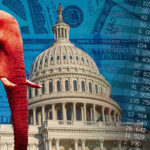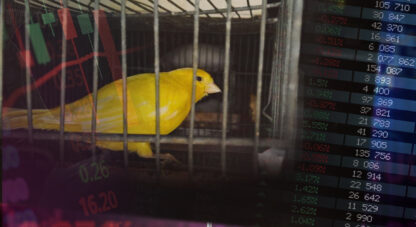This week’s disappointing ISM reports dominated business headlines: “US Manufacturing Survey Shows Worst Reading in a Decade.” “U.S. Factory Gauge Hits 10-Year Low as World Slowdown Widens.” “U.S. Manufacturers Experience Worst Month Since 2007-2009 Great Recession.” “ISM Services Index Hits Three-Year Low, Missing All Estimates.” “Services Survey Shows Economy is Weaker Than Expected Amid Slowdown Fears.”
A Google news search for recent “money supply” articles yields slim pickings: Apparently, China’s Xinhua news agency is now the go-to source for U.S. money supply insight: “U.S. Fed’s M2 Money Stock Rises as Market Bets Another Rate Cut.” Other top results included, “Egypt’s M2 Money Supply Rises 11.78% Year-On-Year in August,” and “Serbia’s M3 Money Supply Grows 12.3% y/y in August.”
Not that many years ago economists and market analysts followed weekly money supply data with keen interest. Rapid monetary expansion was, after all, indicative of excessive Credit growth and attendant inflationary pressures. Slowing money growth would indicate a tightening of lending conditions or waning demand for Credit. The Federal Reserve and global central bankers duly monitored the monetary aggregates as an indication of the appropriateness of monetary policies. Indeed, money and Credit had been a prime focus since the establishment of central banks. Throughout its history, the Federal Reserve was expected to prudently manage the “money” supply to ensure stable prices.
M2 “money” supply surged $70.2 billion last week, the strongest advance since the week of January 11, 2016. Notable to be sure, but apparently not worthy of a headline or article. Moreover, M2 was up $262 billion in 10-weeks and $575 billion over 22 weeks. The Fed’s weekly H.6 “Money Stock and Debt Measures” report presented a 13-week seasonally-adjusted M2 growth rate of 8.5%.
Let’s focus on the extraordinary $575 billion M2 expansion over the past 22 weeks (that receives zero attention). This was the second strongest (22-week) monetary expansion in U.S. history, trailing only 2011’s “QE2” period (Fed expanded holdings by $600 billion) where M2 expanded as much as $616 billion over 22 weeks. M2 growth peaked at $530 billion (over 22 weeks) in February 2009 during the Federal Reserve’s inaugural QE operation.
Breaking down the recent $575 billion M2 expansion, Currency gained $44 billion and Total Demand Deposits rose $21 billion. Meanwhile, Savings Deposits at Commercial Banks surged $332 billion (Total Savings Deposits up $346bn), with Total Small Time Deposits rising $8 billion. Over this period, Retail Money Fund deposits (included in M2) jumped $103 billion.
The Fed some years back discontinued tabulating a broader “M3” aggregate. It does, however, report Institutional Money Fund deposits, previously a key component of M3. It’s certainly worth highlighting that Institutional Money Funds expanded $256 billion over the past 22 weeks, a 32% annualized growth rate. Combining M2 and Institutional Money Funds, growth in this aggregate reached $831 billion over the past 22 weeks (to $17.666 TN), a blistering 11.9% annualized growth rate.
In last week’s analysis of the Fed’s Q2 Z.1 report, I noted the strong pickup in Bank lending (Q2 6.8% annualized) along with the notable $710 billion nine-month surge in the “repo” market (Federal Funds and Securities Repurchase Agreements). It’s no coincidence that these developments corresponded with rapid growth in both commercial bank savings deposits and institutional money fund assets, along with the collapse in Treasury and corporate bond yields (surge in prices).
September 30 – Financial Times (Joe Rennison): “Companies around the world sold a record amount of bonds last month, taking advantage of low borrowing costs fueled by investors’ frenzied search for yield. September tends to be a busy period for the bond market… That trend was amplified this year by a global rally in government bonds in August which lowered interest costs for a host of companies looking to sell debt. A total of $434bn of corporate bonds were sold globally in September, according to… Dealogic. That sum… was about $5bn higher than the previous high of March 2017. ‘It’s very attractive for issuers coming into the market right now,’ said Monica Erickson, a portfolio manager at… DoubleLine.”
October 1 – Bloomberg (Finbarr Flynn and Hannah Benjamin): “Companies globally sold a record amount of bonds in September as investors hungry for yield poured into debt, betting that major central banks can keep the global economy out of a recession… September’s new U.S. investment-grade debt supply reached $158 billion, making it the third-largest month ever for issuance. It was a month for the record books: an unprecedented 130 issuers tapped debt capital markets after a frenzied start that made the first week the busiest market participants had seen in their careers.”
September 30 – The Bond Buyer (Aaron Weitzman): “Municipal bond volume continues to accelerate, closing out the month of September 39.1% higher and the quarter 17.8% higher than a year earlier, as issuers flocked to market with taxable deals. September volume rose to $35.38 billion of municipal bonds sold in 894 transactions…”
I have posited that a bond market “melt-up” was instrumental in what has been a period of extraordinary Monetary Disorder. A weakening global economic backdrop along with escalating trade war risks and fragile markets spurred a dovish U-turn by the Fed, ECB and global central banks generally. The global yield collapse was largely fueled by a combination of speculative excess and risk market hedging. Such strategies have focused on safe haven sovereign and investment-grade corporate debt as instruments that would see inflating prices in the event of a “risk off” backdrop and resulting central bank rates cuts and QE.
The surge in speculative leverage – exemplified by enormous “repo” market expansion – created a self-reinforcing surge in marketplace liquidity, of which a portion flowed into the “money” supply aggregates (notably through the expansion of commercial bank saving deposits and institutional money fund assets). Moreover, it’s my view that the abrupt September reversal of market yields and the prospect of end-of-quarter liquidity challenges spurred a reversal of some levered holdings that quickly manifested into a liquidity shortage and spike in overnight funding costs.
Federal Reserve Credit jumped $83.9 billion last week to $3.893 TN, the strongest weekly Fed balance sheet expansion since March 2009. This pushed four-week Federal Reserve liquidity operations to $170.5 billion – taking Fed Credit to the highest level since the week of April 17th.
I’ll assume at least some of this expansion will be reversed as quarter-end positioning normalizes in the marketplace (leverage reversed for reporting purposes is reestablished). Yet I view the eruption of acute repo market instability as an urgent signal of mounting financial market instability. The Fed seemingly agrees.
October 4 – Financial Times (Joe Rennison, Colby Smith and Brendan Greeley): “The Federal Reserve Bank of New York will extend its intervention in the repo market into November…, soothing concerns about a re-emergence of the cash crunch that sent short-term interest rates soaring in September. The New York Fed first stepped into the repo market… after the cost of borrowing money overnight quadrupled to 10% last month. It intensified its efforts heading into the end of September to ward off potential strain at the end of the third quarter… The markets arm of the US central bank announced that it would continue to inject $75bn in overnight loans into the repo market every day through to November 4. In addition, it would conduct a series of term-repo operations — loans ranging from six to 15 days — to maintain an additional $140bn in the market until early November. The announcement has helped ease traders’ concerns of a potential shortage of cash re-emerging when close to $140bn in existing two-week term repo loans rolls off next week.”
U.S. equities reversed higher after Friday’s “Goldilocks” jobs report. But the rally gained momentum on the New York Fed’s “repo” extension announcement. Late Friday afternoon, Cleveland Fed President Loretta Mester reiterated a comment made by her colleagues: “The Fed’s decision on reserve supplies isn’t about QE.” The problem is that Fed liquidity operations, and the resulting expansion in Fed Credit, is very much about backstopping the markets. Markets are not bothered by a “QE” or “overnight repo operation” label. Rather, the Fed’s aggressive measures further crystallize the market view the Fed (and global central bankers) has little tolerance for fledgling market instability. For good reason, markets expect central banks to respond with overwhelming force to any issue that risks unleashing latent Crisis Dynamics.
At 3.5%, the U.S. unemployment rate in September hit a 50-year low. Money supply is booming. It was the third-largest month ever for investment-grade debt issuance. The St. Louis Fed’s weekly forecast for Q3 GDP growth is up to 3.12%, which would be the strongest reading since Q3 ’18. With the tailwind of low mortgage rates, housing markets are gaining momentum. New Home Sales are running at the strongest pace since 2007. August Existing Home Sales were reported at the strongest pace since March 2018. Weekly mortgage purchase applications have recently been running about 10% above the year ago level. And at a 17.19 million annualized pace, auto sales held up solidly in September. The consumer is working, earning, borrowing and spending.
This week’s ISMs – manufacturing and non-manufacturing – both significantly missed estimates. Manufacturing is undoubtedly weak, with attention focused on the much larger non-manufacturing sector for indications of a broadening slowdown. At 52.6, the ISM Non-Manufacturing index is still expanding.
The implied yield on January Fed funds futures declined 10.5 bps this week to 1.47%, boosting the two-week drop to 16 bps. This implies market expectations for 36 bps of additional rate cuts by January. Markets are now pricing in a 73% probability of a cut at the Fed’s October 30th meeting (down from Thursday’s 85%). Two-year Treasury yields sank 23 bps this week to 1.41%. European bank stocks were slammed 4.7%. Bank stocks were down 3.0% in the U.S. and 2.7% in Japan.
I would tend to somewhat downplay current U.S. economic weakness. These are clearly abnormal times, but it would be atypical for such loose financial conditions not to support economic activity (for now). Global markets are a different story. Myriad co-dependent Bubbles appear more vulnerable by the week – while monetary stimulus and prospects for additional QE only exacerbate excesses along with fragilities. Trade negotiations remain a major wildcard. Increasingly, impeachment proceedings and rancid Washington pandemonium add a layer of complexity upon a highly complex backdrop. Taking it one week at a time, there’s palpable pressure on the administration to make some headway with the Chinese.
For the Week:
In a volatile week, the S&P500 slipped 0.3% (up 17.8% y-t-d), and the Dow declined 0.9% (up 13.9%). The Utilities added 0.2% (up 23.4%). The Banks dropped 3.0% (up 13.3%), and the Broker/Dealers sank 7.2% (up 4.2%). The Transports lost 3.0% (up 9.4%). The S&P 400 Midcaps fell 1.0% (up 14.5%), and the small cap Russell 2000 slumped 1.3% (up 11.3%). The Nasdaq100 advanced 0.9% (up 22.5%). The Semiconductors jumped 2.0% (up 36.3%). The Biotechs increased 0.4% (down 0.1%). With bullion gaining $8, the HUI gold index added 0.3% (up 31.6%).
Three-month Treasury bill rates ended the week at 1.66%. Two-year government yields sank 23 bps to 1.41% (down 108bps y-t-d). Five-year T-note yields dropped 22 bps to 1.35% (down 116bps). Ten-year Treasury yields fell 15 bps to 1.53% (down 116bps). Long bond yields declined 11 bps to 2.02% (down 100bps). Benchmark Fannie Mae MBS yields dropped 15 bps to 2.47% (down 103bps).
Greek 10-year yields added a basis point to 1.33% (down 306bps y-t-d). Ten-year Portuguese yields declined three bps to 0.14% (down 158bps). Italian 10-year yields increased one basis point to 0.83% (down 191bps). Spain’s 10-year yields declined two bps to 0.13% (down 128bps). German bund yields fell another basis point to negative 0.59% (down 83bps). French yields were unchanged at negative 0.28% (down 99bps). The French to German 10-year bond spread widened one to 31 bps. U.K. 10-year gilt yields dropped six bps to 0.44% (down 83bps). U.K.’s FTSE equities index sank 3.6% (up 6.4% y-t-d).
Japan’s Nikkei Equities Index fell 2.1% (up 7.0% y-t-d). Japanese 10-year “JGB” yields declined three bps to negative 0.2% (down 2bps y-t-d). France’s CAC40 dropped 2.7% (up 16.0%). The German DAX equities index sank 3.0% (up 13.8%). Spain’s IBEX 35 equities index slumped 2.4% (up 4.9%). Italy’s FTSE MIB index fell 2.5% (up 17.2%). EM equities were mostly lower. Brazil’s Bovespa index dropped 2.4% (up 12.7%), while Mexico’s Bolsa gained 1.3% (up 4.3%). South Korea’s Kospi index declined 1.4% (down 1.0%). India’s Sensex equities index sank 3.0% (up 4.4%). China’s Shanghai Exchange declined 0.9% (up 16.5%). Turkey’s Borsa Istanbul National 100 index lost 1.6% (up 13.4%). Russia’s MICEX equities index dropped 2.4% (up 13.6%).
Investment-grade bond funds saw inflows of $733 million, and junk bond funds posted inflows of $198 million (from Lipper).
Freddie Mac 30-year fixed mortgage rates added a basis point to 3.65% (down 106bps y-o-y). Fifteen-year rates declined two bps to 3.14% (down 101bps). Five-year hybrid ARM rates were unchanged at 3.38% (down 63bps). Bankrate’s survey of jumbo mortgage borrowing costs had 30-year fixed rates down six bps to 3.98% (down 89bps).
Federal Reserve Credit last week surged $83.9bn to $3.892 TN. Over the past year, Fed Credit contracted $253bn, or 6.1%. Fed Credit inflated $1.082 Trillion, or 38%, over the past 360 weeks. Elsewhere, Fed holdings for foreign owners of Treasury, Agency Debt dropped $17.1bn last week to $3.441 TN. “Custody holdings” increased $5.3bn y-o-y, or 0.2%.
M2 (narrow) “money” supply surged $70.2bn last week to a record $15.092 TN. “Narrow money” gained $840bn, or 5.9%, over the past year. For the week, Currency increased $2.4bn. Total Checkable Deposits rose $22.3bn, and Savings Deposits jumped $41.5bn. Small Time Deposits dipped $3.4bn. Retail Money Funds gained $7.4bn.
Total money market fund assets jumped $20.2bn to $3.463 TN. Money Funds gained $597bn y-o-y, or 20.8%.
Total Commercial Paper declined $4.7bn to $1.93 TN. CP was down $7.6bn y-o-y, or 0.7%.
Currency Watch:
The U.S. dollar index slipped 0.3% to 98.84 (up 2.8% y-t-d). For the week on the upside, the Brazilian real increased 2.6%, the Japanese yen 0.9%, the Mexican peso 0.9%, the South African rand 0.5%, the New Zealand dollar 0.4%, the euro 0.4%, the British pound 0.3%, the South Korean won 0.3%, the Singapore dollar 0.2% and the Australian dollar 0.1%. On the downside, the Canadian dollar declined 0.5%, the Swiss franc 0.5%, the Swedish krona 0.5% and the Norwegian krone 0.2%. The Chinese renminbi declined 0.36% versus the dollar this week (down 3.77% y-t-d).
Commodities Watch:
September 29 – Reuters (Matt Spetalnick and Timothy Gardner): “Saudi Arabia’s crown prince warned… that oil prices could spike to ‘unimaginably high numbers’ if the world doesn’t come together to deter Iran, but said he preferred a political solution to a military one… ‘If the world does not take a strong and firm action to deter Iran, we will see further escalations that will threaten world interests,” Prince Mohammed, known as MbS, said… ‘Oil supplies will be disrupted and oil prices will jump to unimaginably high numbers that we haven’t seen in our lifetimes.’”
The Bloomberg Commodities Index declined 0.5% this week (up 1.2% y-t-d). Spot Gold rallied 0.5% to $1,505 (up 17.3%). Silver slipped 0.2% to $17.625 (up 13.4%). WTI crude fell $3.10 to $52.81 (up 16%). Gasoline sank 4.7% (up 19%), and Natural Gas dropped 2.2% (down 20%). Copper lost 1.3% (down 3%). Wheat increased 0.7% (down 3%). Corn jumped 3.6% (up 3%).
Market Instability Watch:
October 1 – Reuters (Kate Duguid): “The New York Federal Reserve… awarded $54.85 billion to primary dealers at an operation of overnight repurchase agreements in an effort to maintain the federal funds rate within its target range of 1.75%-2.00%. Tuesday’s amount was smaller than the $63.5 billion in overnight repos the regional central bank awarded on Monday…”
October 2 – Bloomberg (Emily Barrett): “Last month’s surge in overnight funding rates arose from a perfect storm. Other squalls may arise before year-end… Some of the catalysts that whipped markets up last month will be back, according to Thomas Simons, money market economist at Jefferies. Another $381 billion of Treasury auctions are on the calendar for the fourth quarter — though that’s smaller than the flurry of auctions that fueled repo turmoil in mid-September. Treasury cash balances will continue to rise, and more corporate taxes will be paid. Add to this a couple of long weekends, which can stir volatility. Then there are wild cards: the U.K.’s Oct. 31 deadline to leave the European Union and the risk of other geopolitical strife.”
September 30 – Bloomberg (Masaki Kondo, Kazumi Miura, and Emily Barrett): “Bond traders just had an inkling of what it could be like when central banks and pension funds aren’t there to support them. Japan’s bond futures tumbled by the most since 2016, triggering margin calls for investors, after the country’s worst 10-year debt auction in three years. Japanese government bond yields climbed and the curve steepened, while the sell-off also spilled into Treasuries and European debt even as euro-area data showed inflation remains lackluster. Behind the sudden collapse in JGBs lies the prospect that the Bank of Japan may slash bond purchases in October, and an announcement that the Government Pension Investment Fund is pivoting toward buying more foreign debt.”
September 30 – Bloomberg (Brandon Kochkodin): “Negative interest rates have quite literally broken one of the pillars of modern finance. As economists and central bankers weigh the pros and cons of sub-zero rates and their impact on the world, traders have been contending with a rather more mundane, but fundamental issue: How to price risk on trillions of dollars of financial instruments like interest-rate swaps when their complex mathematical models simply don’t work with negative numbers. Out are certain variations of the Black-Scholes model, the framework that allowed derivatives to flourish in the past four decades. In are a hodgepodge of approximations and workarounds, including one dating to the 19th century.”
Trump Administration Watch:
September 30 – Bloomberg (Shawn Donnan, Jenny Leonard and Saleha Mohsin): “The Trump administration has issued a partial — and qualified — denial to the revelation that it is discussing imposing limits on U.S. investments in Chinese companies and financial markets as China vowed to continue opening its markets to foreign investment. Bloomberg… reported that Larry Kudlow… was leading deliberations inside the White House over what some hawks have labeled a potential ‘financial decoupling’ of the world’s two largest economies. The options discussed have included forcing a delisting of Chinese companies from U.S. exchanges, imposing limits on investments in Chinese markets by U.S. government pension funds and putting caps on the value of Chinese companies included in indexes managed by U.S. firms…”
September 30 – Bloomberg (Shawn Donnan): “News that the White House is considering broadening its trade war with China into a financial flow war and discussing controls on capital coursing between the U.S. and China shook financial markets on Friday. So it is worth pointing out the context. What unnerved markets about the internal deliberations… was that they seemed like an extreme departure from the U.S.’s longstanding free-market orthodoxy. U.S. officials have for decades advocated opening financial markets around the world to capital. That the discussion is even taking place, therefore, is eye-popping for many in the world of international finance. Yet the Trump administration’s deliberations are not happening in isolation. Some of the loudest backers of the tariffs… imposed also advocate capital controls aimed at both managing what they see as damaging currency imbalances and limiting China’s access to America’s financial might.”
October 2 – Reuters (Tim Hepher, Philip Blenkinsop and David Lawder): “The United States… said it would slap 10% tariffs on European-made Airbus planes and 25% duties on French wine, Scotch and Irish whiskies, and cheese from across the continent as punishment for illegal EU aircraft subsidies. The announcement came after the World Trade Organization gave Washington a green light to impose tariffs on $7.5 billion worth of EU goods annually in the long-running case, a move that threatens to ignite a tit-for-tat transatlantic trade war.”
October 3 – Associated Press (Lorne Cook and Barry Hatton): “The European Union warned… it will retaliate against the U.S. decision to slap tariffs on a range of the bloc’s exports – from cheese to wine – that could cause job losses in Europe and price increases for Americans. The Trump administration’s decision to put new import taxes on EU goods worth $7.5 billion opened a new chapter in the global trade wars that are heightening fears of a global recession. The latest tariffs target large aircraft but also many typical European products such as olives, whiskey, wine, cheese and yogurt. They will take effect Oct. 18 and amount to a 10% tax on EU aircraft and steep 25% rate on everything else.”
October 1 – Reuters (Susan Heavey and Jason Lange): “U.S. President Donald Trump once again lashed out at the Federal Reserve…, this time in the wake of weak data on the manufacturing sector, saying the central bank has kept interest rates ‘too high’ and that a strong dollar is hurting U.S. factories. ‘As I predicted, Jay Powell and the Federal Reserve have allowed the Dollar to get so strong, especially relative to ALL other currencies, that our manufacturers are being negatively affected. Fed Rate too high. They are their own worst enemies, they don’t have a clue. Pathetic!’ Trump wrote.”
Federal Reserve Watch:
September 30 – Financial Times (Brendan Greeley, Laura Noonan, Joe Rennison, Robert Armstrong and Colby Smith): “The Federal Reserve is looking at whether regulation played a role in the sudden rise in short-term interest rates that rocked markets last month, when the largest US banks, despite being flush with cash reserves, did not lend them out overnight as expected. The central bank has indicated that it is focused on the concentration of reserves among a few banks and said it will consider the question at its next monetary policy meeting on October 29-30. According to policymakers, traders and bank executives, that concentration contributed to the rise in two ways. Larger banks have to meet higher regulatory standards for cash, particularly for same-day liquidity that only reserves can provide. And larger banks have different strategies for their own reserve holdings, which may not include lending them out overnight.”
September 29 – Bloomberg (Rich Miller): “They say it’s better to eat organic. But when it comes to the Federal Reserve’s balance sheet, Wall Street is hungering for a lot more. Financial analysts argue that the Fed needs to buy anywhere from about $200 billion to a half a trillion dollars in Treasury securities to bulk up its balance sheet and reduce the risk of money-market turmoil. Such a massive operation would seemingly be far bigger than the ‘organic’ balance sheet growth that many Fed policy makers are currently talking about. It would also be sure to draw comparisons to the quantitative easing programs that the central bank employed during the financial crisis and which President Donald Trump has spoken of approvingly.”
October 1 – Reuters (Balazs Koranyi and Francesco Canepa): “The Federal Reserve has set monetary policy to where it can deliver on its 2% inflation goal and there is scope to raise rates slightly over the next few years if the economy continues to grow, Chicago Fed President Charles Evans said…”
October 3 – Reuters (Jesus Aguado): “The U.S. Federal Reserve continues to enjoy ‘a reasonable amount of independence’ and is focused on its mandate despite criticism of its policy moves by U.S. President Donald Trump, Chicago Federal Reserve Bank President Charles Evans said… ‘People get to criticize you … (but) what we need to do is to keep our head down and pay attention to our mandated objective’ of employment and inflation, Evans told a conference in Madrid.”
U.S. Bubble Watch:
October 1 – Wall Street Journal (Amara Omeokwe, Paul Hannon and Austen Hufford): “U.S. factory activity contracted for the second straight month in September and hit a 10-year low, triggering fresh concerns about the economy and a broad stock-market decline. The U.S. manufacturing readings were among several data points released Tuesday pointing towards the global impact of the U.S.-China trade war, as trade flows are set to grow this year at the weakest pace since the financial crisis, with rising tariffs and cooling growth. The Institute for Supply Management reported its manufacturing index fell to 47.8 in September, the lowest level since June 2009, from 49.1 the prior month.”
October 3 – Bloomberg (Reade Pickert): “America’s service industries joined manufacturing in taking a big step back last month, fueling concerns that the global slowdown and trade war are weighing more on the broader economy…. The Institute for Supply Management’s non-manufacturing index dropped 3.8 points to 52.6 in September, the lowest since August 2016 and well below the most pessimistic forecast…Growth in orders and business activity slowed abruptly, while the employment gauge registered its weakest print in more than five years.”
September 30 – Bloomberg (Caleb Mutua and Molly Smith): “The great deleveraging that was supposed to sweep over corporate America is dead. Or, at least, on hold. Blue-chip companies have begun to ramp up borrowing again as central banks globally flood economies with money. Liabilities have reached their highest level relative to income since 2009, according to Morgan Stanley’s analysis of second-quarter data. The number of companies selling investment-grade debt this month through Thursday has surged 63% from the same period last year… Around 40% of investment-grade companies now have obligations that are more consistent with junk ratings, according to Morgan Stanley.”
September 28 – Bloomberg (Jenny Leonard, Shawn Donnan, and Saleha Mohsin): “A U.S. Treasury official said there are no current plans to stop Chinese companies from listing on U.S. exchanges, a day after a report that the Trump administration is discussing ways to limit U.S. investors’ portfolio flows into China. ‘The administration is not contemplating blocking Chinese companies from listing shares on U.S. stock exchanges at this time,’ Treasury spokeswoman Monica Crowley said…”
September 28 – Bloomberg (Crystal Tse and Michael Hytha): “WeWork, Peloton, Endeavor, Poshmark and more just got the message: It’s not a great time to go public. Disappointing initial public offerings and unsettled economic conditions could shut down many IPOs for the rest of the year — and maybe well into 2020, when the next batch of marquee IPO candidates like Airbnb could meet an even gloomier market and geopolitical environment. The Hollywood agency Endeavor Group Holdings Inc. shelved its IPO… Poshmark Inc., an online resale marketplace for second-hand clothing, is expected to postpone its IPO into next year. Also in flux are a range of stock offerings from e-commerce companies and cybersecurity firms Palantir Technologies Inc., Postmates Inc., and McAfee Inc.”
September 29 – Wall Street Journal (Peter Grant and Keiko Morris): “Turmoil at WeWork is causing the shared-office-space company to all but stop signing new leases, a fresh blow to New York City’s already softening commercial real-estate market. Since We Co. Chief Executive Adam Neumann stepped down…, the company has reversed its rapid growth strategy, looking to slow its expansion, shed head count and assets, and move closer to profitability. That new approach initially included a decision to forgo signing any new leases…”
September 30 – Wall Street Journal (Eliot Brown): “For years, WeWork’s parent company was defined by big spending as it relentlessly pursued rapid growth. Now, in the aftermath of a botched initial public offering attempt and the ouster of co-founder and chief executive Adam Neumann, it is facing a different reality: It needs to stop bleeding cash. On Monday, We Co. said it would file a request with the Securities and Exchange Commission to withdraw its IPO proposal… To cut costs, the company’s new co-CEOs, Sebastian Gunningham and Artie Minson, are planning thousands of job cuts, putting extraneous businesses up for sale and purging some luxuries from the previous CEO, such as a G650ER jet purchased for more than $60 million last year…”
September 29 – Wall Street Journal (Christopher M. Matthews and Rebecca Elliott): “The American shale boom is slowing as innovation plateaus—and just when shale’s importance in global markets has reached new highs following an attack on the heart of Saudi Arabia’s oil infrastructure. U.S. oil production increased by less than 1% during the first six months of the year…, down from nearly 7% growth over the same period last year. Unlike several years ago, when shale production fell due to a global price collapse, the slowdown this year is driven partly by core operational issues, including wells producing less than expected after being drilled too close to one another, and sweet spots running out sooner than anticipated.”
October 2 – CNBC (Diana Olick): “After a rough month for mortgage rates, borrowers saw a sign of hope and pounced: A small dip in the 30-year fixed rate lit a fire under refinances. That pushed total mortgage application volume up 8% for the week, according to the Mortgage Bankers Association’s seasonally adjusted index… Mortgage applications to purchase a home rose just 1% for the week but were 10% higher annually.”
October 1 – Wall Street Journal (Ben Eisen and Adrienne Roberts): “Walk into an auto dealership these days and you might walk out with a seven-year car loan. That means monthly payments that last well past when the brake pads give out and potentially beyond when the car gets traded in for a new one. About a third of auto loans for new vehicles taken in the first half of 2019 had terms of longer than six years, according to… Experian PLC. A decade ago, that number was less than 10%. Car loans that are increasingly stretched out are a pronounced sign that some American middle class buyers can’t afford a middle-class lifestyle.”
October 2 – Bloomberg (Oshrat Carmiel): “Resale prices for Manhattan apartments tumbled the most in seven years, pushed down by buyer demands for discounts in a market swamped with choices. Previously owned condos and co-ops sold for a median of $915,000 in the third quarter, down 8% from a year earlier, appraiser Miller Samuel Inc. and brokerage Douglas Elliman Real Estate reported. It was the first decline in the past 10 quarters and the biggest since the third quarter of 2012. ‘It’s just more signs that the sellers are capitulating,’ Jonathan Miller, president of Miller Samuel, said… ‘The market is going through what could be called a reset.’”
September 30 – Reuters (Sanjana Shivdas): “The U.S. office vacancy rate rose marginally to 16.8% in the third quarter from a year earlier, according to real estate research firm Reis Inc. Of the 79 metropolitan areas covered by Reis, 29 showed a rise in vacancies in the quarter.”
September 29 – Reuters (Richa Naidu and Aishwarya Venugopal): “Fast-fashion retailer Forever 21 filed for bankruptcy late on Sunday, joining a growing list of brick-and-mortar companies that have seen sales hit by the rise of competition from online sellers like Amazon.com Inc and the changing fashion trends dictated by millennial shoppers.”
China Watch:
September 30 – CNBC (Evelyn Cheng): “Chinese President Xi Jinping said… in a speech commemorating the 70th anniversary of the Chinese Communist Party’s rule that no force could sway China’s development. ‘There is no force that can shake the foundation of this great nation,’ Xi said… ‘No force can stop the Chinese people and the Chinese nation forging ahead.’ Xi did not specifically mention any other country by name, and emphasized that China would pursue peaceful development. ‘Long live the great Communist Party of China. And long live the great Chinese People!’ Xi concluded his speech…”
September 29 – Associated Press: “China’s top trade negotiator will lead an upcoming 13th round of talks aimed at resolving a trade war with the United States… Vice Premier Liu He will travel to Washington for the negotiations, Vice Commerce Minister Wang Shouwen said… ‘The two sides should find a solution through equal dialogue in accordance with the principle of mutual respect, equality and mutual benefit,’ Wang said…”
September 30 – Bloomberg (Ben Bartenstein): “The U.S.-China trade war is getting ‘considerably worse’ and comments at the United Nations General Assembly suggest no end in sight, according to Ian Bremmer, …president of Eurasia Group. Chinese officials will be patient, hoping to maintain the status quo while making no serious attempts at a breakthrough deal until after the 2020 U.S. election, Bremmer wrote… He said China’s Foreign Minister Wang Yi’s combative tone suggests a much deeper divide between the world’s two largest economies than six months ago. ‘The two sides are digging in and it’s gotten considerably worse in the past weeks,’ Bremmer said.”
September 29 – Reuters (Stella Qiu and Ryan Woo): “China’s factory activity unexpectedly expanded at the fastest pace in 19 months in September as plants ramped up production and new orders rose, …suggesting a modest recovery in the manufacturing sector from 50.4 in August, marking the second straight month of expansion.”
September 30 – Wall Street Journal (Shen Hong): “China is snapping up stakes in private companies at a record rate… The investments mark a reversal after decades in which state-owned enterprises have shrunk in importance, as reflected in measures such as their share of the workforce or asset ownership. Since China’s public-sector companies are typically less efficient or innovative than their private rivals, the shopping spree could lead to a fresh drag on growth. Private enterprises are in a weaker position because they have comparatively poorer access to cheap bank loans and other types of financing, and have also been squeezed by Beijing’s moves to reduce pollution and overproduction… In total, state-backed buyers bought 47 stakes in listed private companies from January through June, according to Fitch…. That compares with 52 deals in all of 2018.”
September 30 – Wall Street Journal (Nathaniel Taplin): “Deng Xiaoping, who launched China’s economic reforms, famously said that it was fine for some people to get rich first. As long as everyone got rich eventually, it was a price worth paying for the communist leader. That narrative, call it the original Chinese dream, was borne out for a long time. China’s opening to the world generated many millionaires and billionaires but also remade China overall into an upper-middle-income society. There are increasing signs, however, that those Chinese who haven’t yet gotten rich will face a far harder time doing so in the future. Following steep falls in the early 2010s, inequality is rising again while real income growth has flatlined… Two subtle changes in China’s economy tell the story. Following a long fall from 2008 to 2015, China’s Gini Coefficient, a measure of income inequality, has begun rising sharply again. Second, since 2016 housing prices have mostly grown much faster than incomes, the opposite of the situation from 2011 to 2015.”
October 2 – New York Times (Alexandra Stevenson): “Forty years after China began its near-miraculous run as the world’s most powerful economic growth engine, its people are experiencing something new and unsettling: a feeling that the best times may be behind them. The Chinese economy is slowing, and the cost of living is rising. The trade war with the United States shows no sign of ending. Wage growth is sluggish. More young people are chasing fewer job prospects. Chinese consumers, who have become more cautious over the past year, are now staging a broad retreat. They are buying fewer cars, smartphones and appliances. They are going to the movies less and taking fewer trips abroad. They would rather stick their money in the bank. For China’s young people, who have never experienced a prolonged slump in their lives, the shift is especially stark.”
October 1 – Reuters (Michael Martina): “China’s military… showed off new equipment at a parade in central Beijing to mark 70 years since the founding of the People’s Republic, including hypersonic-glide missiles that experts say could be difficult for the United States to counter… As expected, China unveiled new unmanned aerial vehicles (UAVs) and showcased its advancing intercontinental and hypersonic missiles, designed to attack the aircraft carriers and bases that undergird U.S. military strength in Asia. A state television announcer called the missile arsenal a ‘force for realizing the dream of a strong nation and strong military.’”
September 29 – Bloomberg (Shirley Zhao): “China is reeling out a string of patriotic films as the Communist Party prepares to celebrate 70 years in power amid challenges to its authority from the unrest in Hong Kong and an economy weakened by the trade war. At least three movies featuring the accomplishments of ordinary Chinese opened in mainland theaters Monday, the eve of the 70th anniversary of the founding of the People’s Republic of China.”
October 2 – Reuters (Clare Jim and Felix Tam): “Hong Kong’s government is expected to discuss sweeping emergency laws… that would include banning face masks at protests, two sources told Reuters, as the Chinese-ruled territory grapples with an escalating cycle of violence. Authorities have already loosened guidelines on the use of force by police…”
September 29 – New York Times (Peter S. Goodman and Austin Ramzy): “In a part of the world familiar with conflict, dislocation and ruthless ideological extremism, Hong Kong has long beckoned as an oasis of stability. It has prospered on the strength of its proximity to mainland China — close enough to be a base for investors capitalizing on China’s development, and still beyond reach of the authoritarian hand of the Chinese Communist Party. It has served as a bridge between two rival powers nursing mutual suspicions, the United States and China. It is Chinese territory yet governed by a legal system inherited from the West, and intertwined with the global financial system. But now Hong Kong’s status as neutral ground between mainland China and the outside world is being threatened by a pair of momentous confrontations.”
September 29 – Reuters (Echo Wang and Joshua Franklin): “Nasdaq Inc is cracking down on initial public offerings (IPOs) of small Chinese companies by tightening restrictions and slowing down their approval, according to regulatory filings, corporate executives and investment bankers. Nasdaq’s attempt to limit these stock market flotations comes as a growing number of them end up raising most of the capital in their IPO from Chinese sources, rather than from U.S. investors.”
Central Banking Watch:
September 30 – Reuters (Swati Pandey): “Australia’s central bank cut interest rates for the third time this year… in a bid to stimulate a sluggish economy and signaled it was prepared to do more if needed, knocking the local dollar to a one-month low… The Reserve Bank of Australia’s (RBA) quarter-point cut took the cash rate to an all-time low of just 0.75%, leaving little room for more reductions and raising the possibility of unconventional policy easing.”
September 29 – Financial Times (Lionel Barber and Claire Jones): “From his corner office on the 40th floor of the European Central Bank’s gleaming twin tower headquarters in Frankfurt, Mario Draghi sums up how the ECB has been transformed during his presidency. ‘[The building] embodies our values,’ says the 72-year-old Italian, with a touch of pride. ‘Transparency and independence.’ Under Mr Draghi, the ECB has come of age. Alongside the Federal Reserve and the Bank of England, it has developed a formidable arsenal, injecting trillions of euros of stimulus into the eurozone economy… Mr Draghi… has won standing ovations at Brussels summits. In May, President Emmanuel Macron awarded him France’s Commandeur de la Légion d’Honneur, praising him as the heir of Jean Monnet and Robert Schuman, the European project’s founding fathers. Yet for all Mr Draghi’s panache, the region’s economy remains fragile. And there is a growing feeling that his central bank has shouldered too much of the burden and can no longer be the only game in town.”
October 1 – Bloomberg (Piotr Skolimowski and Boris Groendahl): “Bundesbank President Jens Weidmann switched the focus of his opposition against European Central Bank stimulus to Mario Draghi himself, suggesting the president should be more open to different points of view. Responding to Draghi’s recent warning that discord among ECB officials could undermine the effectiveness of monetary policy, the German central-bank chief said an ‘intensive discussion’ about far-reaching measures such as bond-buying is not only normal, but ‘absolutely necessary.’ ‘The Austrian philosopher Karl Popper once stated that only a critical discourse could give us the maturity to consider an idea from many different perspectives and to judge it correctly… United in diversity’ is more than the motto of the European Union, which for some may seem abstract. It’s also the concrete mission to approach each other and bring people together.’”
Europe Watch:
October 3 – Bloomberg (Piotr Skolimowski): “The euro-area economy stagnated at the end of the third quarter, held back by an industrial recession and a sharper-than-expected slowdown in services. While the slump still remains broadly centered on manufacturing, the measure for services dropped last month to the lowest since January after being revised down from an initial estimate. If that’s a sign that the weakness is spreading, it’s a worrying development for the euro-area economy. A separate report showed U.K. services unexpectedly shrank, posting the weakest index reading since the Brexit referendum in 2016.”
October 3 – Bloomberg (Fergal O’Brien): “Germany’s economic woes are becoming more pronounced, with a sharp slowdown in services suggesting the pain from its industrial crisis is spreading. While the weakness is still largely centered on manufacturing, a downward revision to services in September adds to the negative news coming from Europe’s largest economy. IHS Markit said the figures mean a technical recession ‘now looks to be all but confirmed.’”
EM Watch:
September 30 – Bloomberg (Rahul Satija): “Mounting debt failures in India have been catching rating companies off guard, underscoring continued challenges a year after the landmark failure of shadow bank IL&FS increased scrutiny of the industry. Defaults at companies including Dewan Housing Finance Corp., Cox & Kings Ltd. and Altico Capital India Ltd. have occurred even as their long-term ratings indicated very low to moderate risk of non-payment. ‘Raters have not been able to detect stress in time,’ said Ashutosh Khajuria, chief financial officer at Federal Bank Ltd. ‘Cutting credit profiles after the defaults is no rocket science.’”
October 2 – Reuters (Nupur Anand): “Private-sector lender Yes Bank’s Chief Executive Officer Ravneet Gill assured investors on Thursday that the bank remains on solid financial footing, sending its stock as much as 25% higher. His remarks come after the stock plunged nearly 23% on Tuesday as fraud allegations against a housing finance company that Yes Bank has exposure to, spooked investors.”
September 30 – Reuters (Davide Barbuscia): “…Fitch downgraded Saudi Arabia’s credit rating to A from A+…, citing rising geopolitical and military tensions in the Gulf following an attack on its oil facilities and a deterioration of the kingdom’s fiscal position. The Saudi finance ministry said it was disappointed by the ‘swift’ downgrade and urged Fitch to reconsider it, arguing the move did not reflect the kingdom’s response to the Sept. 14 attack or its capacity to handle adversity.”
Japan Watch:
September 30 – Bloomberg (Chikako Mogi): “The Bank of Japan signaled potential deep cuts in bond purchases in October, taking what could be its biggest step yet to steepen the yield curve. The central bank slashed the purchase ranges for four major maturities, indicating it may even stop buying debt of more than 25 years… It sought to anchor yields from the one-to-three year zone by raising purchases in a regular operation earlier in the day and lifting the purchase band for the sector in October. Governor Haruhiko Kuroda has repeatedly expressed concern about an excessive flattening of the yield curve… A more aggressive stance on cuts to buying has taken hold as it became clearer that reducing purchases needn’t immediately lead to strengthening of the yen.”
September 30 – Reuters (Tetsushi Kajimoto): “Japan rolled out a twice-delayed increase in the sales tax to 10% from 8% on Tuesday, a move that is seen as critical for fixing the country’s tattered finances but that could tip the economy into recession by dampening consumer sentiment.”
October 2 – Reuters (Tetsushi Kajimoto): “A Bank of Japan board member with a casting vote on policy decisions said the central bank must consider ‘preventive steps’ against economic risks, a sign its nine-member board may be tilting toward further easing as global pressures intensify. …Yukitoshi Funo – who has consistently voted with the majority of the nine-member board and holds a neutral stance – stressed the BOJ’s resolve to act without hesitation if economic hazards increase.”
Global Bubble Watch:
October 3 – Bloomberg Businessweek (Davide Scigliuzzo, Kelsey Butler, and Sally Bakewell): “Private equity managers won the financial crisis. A decade since the world economy almost came apart, big banks are more heavily regulated and scrutinized. Hedge funds… have mostly lost their flair. But the firms once known as leveraged buyout shops are thriving. Almost everything that’s happened since 2008 has tilted in their favor. Low interest rates to finance deals? Check. A friendly political climate? Check. A long line of clients? Check. The PE industry, which runs funds that can invest outside public markets, has trillions of dollars in assets under management. In a world where bonds are paying next to nothing… many big investors are desperate for the higher returns PE managers seem to be able to squeeze from the markets. The business has made billionaires out of many of its founders. Funds have snapped up businesses from pet stores to doctors’ practices to newspapers. PE firms may also be deep into real estate, loans to businesses, and startup investments—but the heart of their craft is using debt to acquire companies and sell them later.”
September 30 – Reuters (Noel Randewich): “Major U.S. fund managers have tens of billion of dollars at stake in some of the most popular Chinese stocks on Wall Street, exposing them to potential losses should the White House move to delist Chinese firms from U.S. exchanges. White House trade adviser Peter Navarro… dismissed reports that the Trump administration was considering delisting Chinese companies from U.S. stock exchanges as ‘fake news’…”
September 30 – Bloomberg (Katrina Nicholas, Matt Turner and Lucca de Paoli): “The risk of a property bubble in the euro zone surged last year as ultra-low interest rates helped drive up house prices. Munich is now the city most vulnerable to a property bubble, according to UBS Group AG’s annual Real Estate Bubble Index. Frankfurt and Paris are increasingly in danger of prices becoming unsustainable, even as some of the priciest cities around the world cool… For the first time in four years, London is no longer regarded as dangerously overvalued.”
Fixed-Income Bubble Watch:
October 1 – Bloomberg (Amanda Albright): “An economically struggling U.S. territory. A government-run electricity provider facing potential insolvency. A debate among public officials about whether debts are too burdensome to pay. That’s the situation in the U.S. Virgin Islands, where the power agency is contending with a financial squeeze that echoes what happened in Puerto Rico in the run up to that government’s record-setting bankruptcy. The uncertainty led Moody’s… on Sept. 23 to downgrade the most senior Virgin Islands Water and Power Authority bonds to eight steps below investment grade, indicating a high likelihood of default.”
Leveraged Speculation Watch:
October 2 – Bloomberg (Lisa Lee): “It’s a marriage between two of Wall Street’s hottest products. Collateralized loan obligations — typically chock-full of broadly-syndicated debt — are increasingly being stuffed with private loans made to highly leveraged medium-sized companies with limited access to bank financing. Known as middle-market CLOs, the asset class has ballooned to $57 billion, from just $20 billion six years ago. Five new entrants this year… suggest issuance is only set to increase. The frenzied growth is another example of how banks, insurance companies and pension funds continue to reach for higher-paying securities in the face of almost $15 trillion of negative-yielding debt around the world. Middle-market CLOs can offer premiums of as much as 200 bps versus their garden-variety peers, in part due to the reduced liquidity that comes with direct lending…”
Geopolitical Watch:
October 2 – Reuters (Vladimir Soldatkin, Dmitry Zhdannikov and Olesya Astakhova): “Washington’s use of the dollar as a political tool is backfiring as more and more countries are reducing their holdings of the greenback and switching to other currencies in trade contracts, Russian President Vladimir Putin said… Putin also said the U.S. was ‘rudely intervening’ in European affairs by objecting to the construction of the Nord Stream gas pipeline.”
October 1 – Reuters (Joyce Lee and Chang-Ran Kim): “North Korea fired what may have been a submarine-launched ballistic missile from off its east coast…, a day after it announced the resumption of talks with the United States on ending its nuclear program. If confirmed, it would be the most provocative test by North Korea since it started the talks with the United States in 2018.”
October 3 – Wall Street Journal (Gordon Lubold and Nancy A. Youssef): “U.S. officials are increasingly concerned that Turkey soon will mount a major incursion into northern Syria and trigger a clash with Kurdish fighters, an action that would likely prompt the Trump administration to remove American forces from Syria to avoid the conflict. Because a U.S. pullout would essentially end the fight against Islamic State there, it could set back ongoing efforts to undercut the group… Both Turkey and the Kurds are allies of the U.S. but are longtime enemies of one another.”
October 2 – Reuters (Ahmed Rasheed and Ahmed Aboulenein): “Iraqi Prime Minister Adel Abdul Mahdi… declared a curfew in Baghdad until further notice after at least seven people were killed and more than 400 were injured during two days of nationwide anti-government protests. Curfews were imposed earlier in three southern cities while elite counter-terrorism troops opened fire on protesters trying to storm Baghdad airport and deployed to the southern city of Nassiriya after gunfights broke out between protesters and security forces…”















